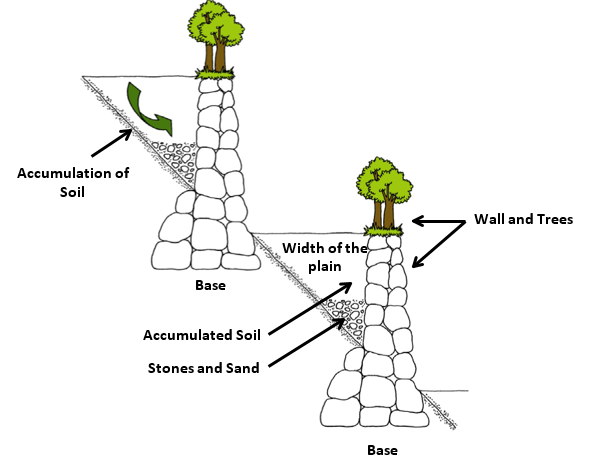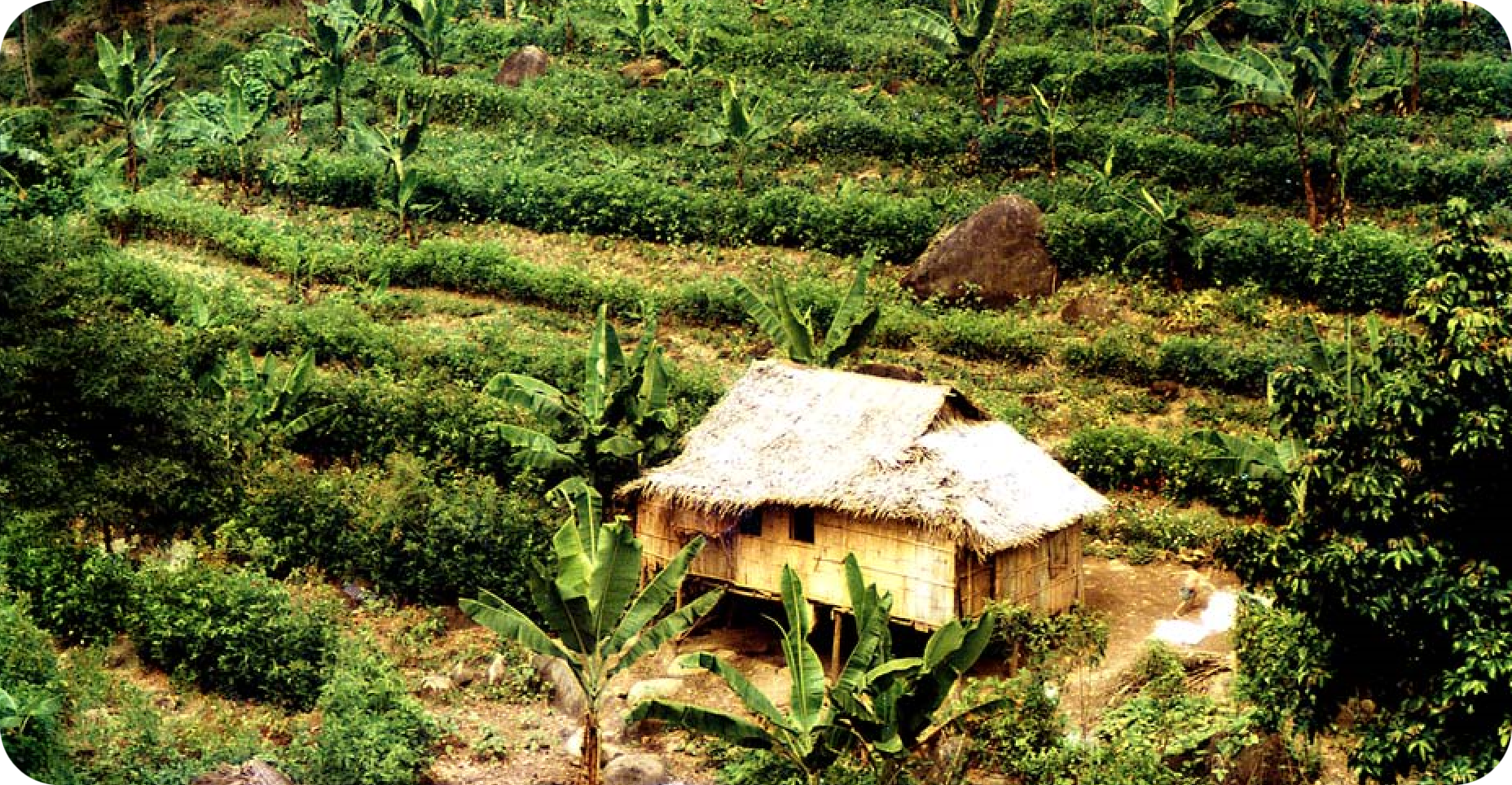Application: Small-scale farmers and farmer groups
Description: A terrace is a levelled surface used in farming to cultivate sloping, hilly or mountainous terrain. They can be used on relatively flat land in cases where soil and climate conditions are conducive to erosion. Terraced fields are effective for growing a wide range of crops such as rice, potatoes, maize, olive trees, and vineyards. Terraces have four main functions: (a) improve the natural conditions for agricultural production; (b) decrease the rate of erosion; (c) increase soil moisture; and (d) generate positive environmental benefits. This technology facilitates adaptation to climate change by optimising water use.
Climate variability also affects the soil, since heavy rainfall coupled with poor soil management give rise to landslides and mudslides. In this respect, slow-formation terraces reduce soil erosion and, consequently, the danger of large landslides occurring. Terraces also regulate the micro-climate for agricultural production. By capturing the sun’s heat in the rock walls, terraces absorb heat during the daytime and release it during the night, helping to create a slightly warmer internal micro-climate which can protect crops from frost, prolong the growing season and allow for crop diversification. This technology is also an important component of SALT.
Slow-forming terraces are constructed with a combination of infiltration ditches, hedgerows, and earth or stonewalls. This technology decreases superficial water run-off, increases water infiltration and intercepts soil sediment. Slow-forming terraces are called as such because they take between three and five years, and possibly even ten years, to fully develop. They can be built on land with marginal to steep inclines and where soil is sufficiently deep to create a drag effect. This leads to the formation of steps as sediment accumulates due to rainfall and natural gravity. Level ditches are traced and excavated along the contour of a slope, and embankments of earth, stones or plants are constructed at regular intervals. Eroded soil accumulates in these buffer strips every year and terraces slowly form. A 1-2 % inclination is recommended to avoid the buffer strips breaking during intense rain. Depending on soil type, ditches should generally be dug 40 cm wide and 40 cm deep. The recommended length of the terrace is between 50-80 m and the height of the slope should be the same as the height of the earth or stone ditches. The best plants to cultivate along the buffer strips are resistant to local conditions and grow well and fast. Where possible, plants that can provide added benefits such as fuelwood and livestock feed should be used. Leguminous species are preferred as they improve the soil nitrogen content.
Lower cost options that also effectively trap sediment but do not require the building of physical structures have also been developed. One option contour planted hedgerows. This system has been used on 10,000 ha of land in the Philippines, Rwanda and Haiti. Double hedges of Leucaena, Gliricidia or similar shrubs are planted four to eight metres apart along the contour. The shrubs are pruned two or three times per year and the leaf and branch material applied to the soil or against the stems of the shrubs, to trap the moving sediment. This leads to the formation of terraces up to 50 cm high in the first two to three years. Another alternative is to use deep rooting grass species such as Vetiver or Panicum bunch grass often used for cut and carry fodder. An even simpler method is to leave natural vegetative strips when preparing the soil for planting, which gradually form the stabilised edges of terraces. These different live-barrier methods of terracing can reduce erosion from 50% to just 2% of the level without live-barriers. Rainfall infiltration is also significantly improved.
Contribution to climate resilience: The key benefits from this adaptation option are as follows: (a) very high relevance at community/farmer level, and (b) low negative impact on environment, and health and safety. It is considered to have a high impact on climate change adaptation because of its perceived benefit from improved land and farm management as a result of improved micro-watershed management. The negative aspects of this technology are high costs and labour demand, impacting on affordability and equity issues. Overall the option is considered to have a medium relative score within the MCA.
Supplementary sources of information:
Antle, J. M., J. J. Stoorvogel and R. O. Valdivia. 2004. Assessing the economic impacts of agricultural carbon sequestration: Terraces and agro-forestry in the Peruvian Andes, Agriculture, Ecosystems & Environment, Vol 122 (4) December 2004, Pp. 435-445
Fantappiè M. (no date) Conservation and Reclamation of Volcanic Deteriorated Soils in Ecuadorian Andes.
ICRAF. 1996. International Center for Research in Agroforestry, Annual Report 1996. ICRAF Nairobi, 240p
Mars, R. 2005. The Basics of Permaculture, Chelsea Green Publishing Company, 2005
Valdivia, R. O. 2002. The Economics of Terraces in the Peruvian Andes: AN application of sensitivity analysis in an integrated assessment model. Montana State University, Bozeman, Montana, April 2002
Young. 1997. Agroforestry for Soil Management. 2nd Edition. CABI/ICRAF Wallingford UK, 320p
This resilience-building measure is sourced from the Adaptation Technologies Guide – Agriculture, Phnom Penh, Cambodia (2019) published by the Ministry of Agriculture, Forestry and Fisheries and the National Council for Sustainable Development at the Ministry of Environment in Cambodia. The full Guide is available to download at URL https://ncsd.moe.gov.kh/sites/default/files/2019-10/Adaptation%20Technologies%20Guide-Agriculture_June%202019_En.pdf


